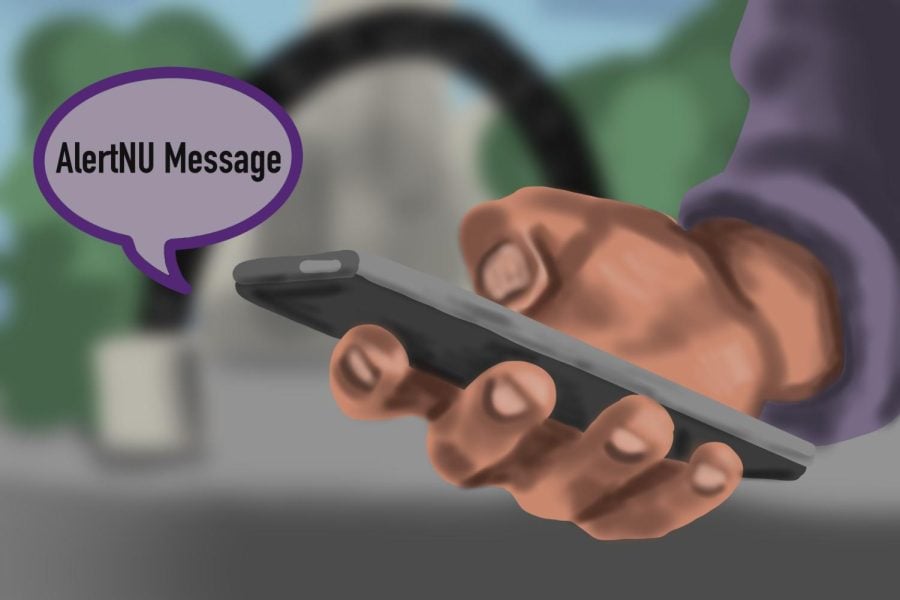Q&A: Luke Figora discusses University communication lapses during Clark Street Beach shooting
The University is working to expand its set of templated messages to send out quickly in the wake of an emergency.
May 22, 2023
Content warning: This article contains mentions of gun violence and death.
On April 12, a shooting on Clark Street Beach left an 18-year-old dead and two 15-year-olds injured.
Students on campus at Northwestern University heard the shots. They reported feeling confusion and fear as the University took more than 30 minutes to issue a shelter-in-place order through email and social media channels. After receiving an emergency alert, students said they heard conflicting information from authorities. Those locked down in buildings including Kresge Centennial Hall and Locy Hall were forced to barricade themselves in classrooms after realizing the doors would not lock.
In the 24 hours following the tragedy, more than 900 students signed a petition calling on the University to reevaluate its emergency alert system.
Luke Figora, NU’s Vice President of Operations, sat down with The Daily to talk about these communications lapses and discussed some of the University’s planned changes.
This interview has been edited and condensed for clarity.
The Daily: What did NU’s emergency communications systems look like before the Clark Street Beach shooting? Was the University aware that its alert system might have flaws?
Figora: The University has an Emergency Response Framework, which is a protocol document for different scenarios. Active shooter scenarios might be one of those, but that’s a kind of a base plan that applies to anything that could impact the campus community. That’s been in place for decades. It’s updated every year.
The communications aspect is one element of that framework. These systems have changed over time, and are tested every year as well.
The Daily: What caused the more than 30-minute delay between the University’s shelter in place order at 8:43 p.m. and when the Evanston Police Department first responded to shots fired on Clark Street Beach at 8:10 p.m.?
Figora: University Police were on the site at around 8:15 p.m. Initially, this was in response, so they were helping EPD on the ground.
EPD was controlling the site and so we were getting information from EPD into the 8:25 to 8:30 p.m. range. The information was “there is no active threat” at the time. That certainly informed the first message that was being prepared for the community.
As that was about to be sent, the information changed. It was close to 8:33 p.m. There was this question of whether there was a vehicle on campus that could have been related to the events. That was the pivot towards the shelter-in-place type message. That change in information occurring midway through the initial response certainly played a role in that overall timeline.
The Daily: About an hour into the shelter-in-place, students received a phone call that said, “University Police are responding to a report of a blank on the Evanston campus at blank.” The University later confirmed this message was sent in error. What caused the error, and what is NU looking to improve in the future? Who is involved in making these changes?
Figora: The system the University uses to send out emergency communications has some default messages in it. Those are messages that really can be sent at the click of a button to the campus community. When you’re not pushing that button, it requires active human drafting of a different message. What we’re trying to do is get an expanded set of canned messages.
The main focus from an emergency communications perspective would be the Department of Safety and Security, which handles dispatch for the University Police — and the office of Global Marketing and Communications, which helps with messaging to the community. One of the things that we’re working on is being really clear about who has the authority to push that button the first time.
The Daily: Some students who were trying to shelter in place found that doors to classrooms they were trying to shelter in wouldn’t lock. Why were those locks left unattended to? What is the University doing now?
Figora: We’ve got a facilities work group that’s looking at building security levels across campus. We have a complex set of buildings across our campus that play different roles. One of the things that we’re looking at is, should there be more of a standard default across all buildings on campus and what would that look like to implement.
The Daily: Students reported miscommunications with faculty and staff in the immediate aftermath of the shooting. Is the University hoping to establish protocols for workers, staff and faculty who might be present during these emergency situations?
Figora: Every individual in the community that’s impacted needs to have some level of situational awareness and every situation is going to be different, so it’s hard to have hard and fast rules.
There is an opportunity for education in terms of what people should do when they hear certain things. Frankly, I think the term “shelter in place” is something we’re evaluating. With shelter in place, what you’re trying to do is just stop people from moving. Some may interpret that as barricading the room. Some may say, “We’re on North Campus and shouldn’t be impacted.” That’s one thing that we’re looking at, if you receive this type of message, here’s what you should do.
We’ve also got the video that’s been updated in the last year with kind of how to respond to active violence-type situations. One of the things we’ll work on over this summer is, “How do we expand that whether it be in video or other form, to educate people a layer deeper?”
Email: [email protected]
Twitter: @joannah_11
Related Stories
— Northwestern provides emergency communication updates following Clark Street Beach shooting


